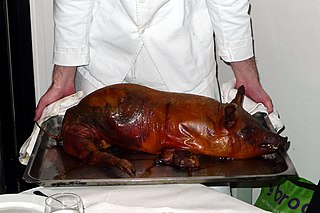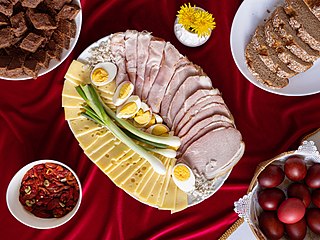
Cantonese or Guangdong cuisine, also known as Yue cuisine, is the cuisine of Guangdong province of China, particularly the provincial capital Guangzhou, and the surrounding regions in the Pearl River Delta including Hong Kong and Macau. Strictly speaking, Cantonese cuisine is the cuisine of Guangzhou or of Cantonese speakers, but it often includes the cooking styles of all the speakers of Yue Chinese languages in Guangdong.

Caribbean cuisine is a fusion of West African, Creole, Amerindian, European, Latin American, Indian/South Asian, Chinese, North American, and Middle Eastern cuisines. These traditions were brought from many countries when they moved to the Caribbean. In addition, the population has created styles that are unique to the region.

Sichuan cuisine or Sichuanese cuisine, alternatively romanized as Szechwan cuisine or Szechuan cuisine is a style of Chinese cuisine originating from Sichuan province and the neighboring Chongqing municipality. Chongqing was formerly a part of Sichuan until 1997; thus, there is a great deal of cultural overlap between the two administrative divisions. There are many regional, local variations of Sichuanese cuisine within Sichuan and Chongqing.

Meze is a selection of small dishes served as appetizers in Armenian, Balkan, Greek, Levantine, and Turkish cuisines. It is similar to Spanish tapas and Italian antipasti. A meze may be served as a part of a multi-course meal or form a meal in itself. Meze are often served with spirits such as arak, rakia, raki, oghi, ouzo, or grappa at meyhane and ouzeri or at regular restaurants.

European cuisine comprises the cuisines originating from the various countries of Europe.

Croatian cuisine is heterogeneous and is known as a cuisine of the regions, since every region of Croatia has its own distinct culinary tradition. Its roots date back to ancient times. The differences in the selection of foodstuffs and forms of cooking are most notable between those in mainland and those in coastal regions. Mainland cuisine is more characterized by Slavic features and influences from the more recent contacts with Turkish, Hungarian and Austrian cuisine, using lard for cooking, and spices such as black pepper, paprika, and garlic. The coastal region bears the influences of Greek and Roman cuisine, as well as of the later Mediterranean cuisine, in particular Italian. Coastal cuisines use olive oil, herbs and spices such as rosemary, sage, bay leaf, oregano, marjoram, cinnamon, clove, nutmeg, and lemon and orange rind. Peasant cooking traditions are based on imaginative variations of several basic ingredients and cooking procedures, while bourgeois cuisine involves more complicated procedures and use of selected herbs and spices. Charcuterie is part of the Croatian culinary tradition in all regions. Food and recipes from other former Yugoslav countries are also popular in Croatia.

Arròs negre or arrós negre is a Valencian and Catalan dish made with cuttlefish and rice, somewhat similar to seafood paella. Some call it paella negra, although it is traditionally not called a paella even though it is prepared in a similar manner.

Sarma is a traditional food in Ottoman cuisine – nowadays, Turkish, Greek, Levantine / Arabic, Armenian, etc. – made of vegetable leaves rolled around a filling of minced meat, grains such as rice, or both. It is commonly marketed in the English-speaking world as stuffed grape leaves, stuffed vine leaves, or stuffed cabbage leaves. The vegetable leaves may be cabbage, patience dock, collard, grapevine, kale or chard leaves. Sarma is part of the broader category of stuffed dishes known as dolma, and has equivalents in Eastern European cuisines from the northern Baltic through Romania.

Gibanica is a traditional pastry dish popular all over the Balkans. It is usually made with cottage cheese and eggs. Recipes can range from sweet to savoury, and from simple to festive and elaborate multi-layered cakes.

Pindjur or pinjur or pinđur, is a relish form and is commonly used as a summer spread. Pindjur is commonly prepared in Bosnia and Herzegovina, Croatia, Bulgaria, Serbia and North Macedonia.

Muhammara or mhammara is a spicy dip made of walnuts, red bell peppers, pomegranate molasses, and breadcrumbs. It is associated with Aleppo, but is also found in Turkey, especially in southeastern regions, where Arab dishes are more common in the local cuisine because of the Syrian cultural influence, as well as in Western Armenian cuisine. In Turkey, muhammara is referred to as acuka and is served as part of the mezze platter appetizer course.

Chrain is a spicy paste made of grated horseradish. It is a common condiment for meat and fish dishes in Eastern and Central European cuisines. Chrain comes from Yiddish כריין, which is in turn a loanword from Slavic languages.

Paprika is a spice made from dried and ground red peppers. It is traditionally made from Capsicum annuum varietals in the Longum group, including chili peppers. Paprika can have varying levels of heat, but the chili peppers used for hot paprika tend to be milder and have thinner flesh than those used to produce chili powder. In some languages, but not English, the word paprika also refers to the plant and the fruit from which the spice is made, as well as to peppers in the Grossum group.

A suckling pig is a piglet fed on its mother's milk. In culinary contexts, a suckling pig is slaughtered between the ages of two and six weeks. It is traditionally cooked whole, often roasted, in various cuisines. It is usually prepared for special occasions and gatherings. The most popular preparation can be found in Spain and Portugal under the name lechón (Spanish) or leitão (Portuguese).

Fisherman's soup or halászlé is a hot, spicy paprika-based fish soup. A folk item of Hungarian cuisine, it is a bright-red hot dish prepared with generous amounts of hot paprika and carp or mixed river fish. It is native to the Pannonian Plain, particularly the Danube and Tisza river regions. It is also a popular dish among ethnic German Donauschwaben and their descendants, known as Karpfensuppe. In Croatia, it is commonly served in the regions of Slavonia and Baranya, where it is called fiš paprikaš.

Balkan cuisine is a type of regional cuisine that combines characteristics of European cuisine with some of those from West Asia. It is found in the Balkan Peninsula of Southeast Europe, a region without clear boundaries but which is generally considered to at least include the modern countries of Albania, Bulgaria, Turkey, Romania and Greece and the former Yugoslavia, with the possible exception of Slovenia and northern inland regions of Croatia.










































